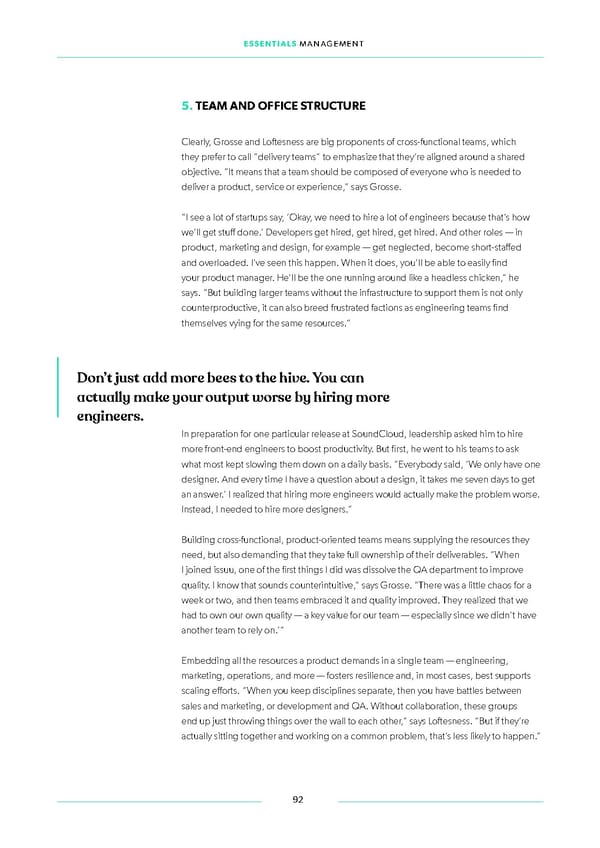ESSENTIALS MANAGEMENT 5. TEAM AND OFFICE STRUCTURE Clearly, Grosse and Lotfesness are big proponents of cross-functional teams, which they prefer to call “delivery teams” to emphasize that they’re aligned around a shared objective. “It means that a team should be composed of everyone who is needed to deliver a product, service or experience,” says Grosse. “I see a lot of startups say, ‘Okay, we need to hire a lot of engineers because that’s how we’ll get stuff done.’ Developers get hired, get hired, get hired. And other roles — in product, marketing and design, for example — get neglected, become short-staffed and overloaded. I’ve seen this happen. When it does, you’ll be able to easily ifnd your product manager. He’ll be the one running around like a headless chicken,” he says. “But building larger teams without the infrastructure to support them is not only counterproductive, it can also breed frustrated factions as engineering teams ifnd themselves vying for the same resources.” Don’t just add more bees to the hive. You can actually make your output worse by hiring more engineers. In preparation for one particular release at SoundCloud, leadership asked him to hire more front-end engineers to boost productivity. But ifrst, he went to his teams to ask what most kept slowing them down on a daily basis. “Everybody said, ‘We only have one designer. And every time I have a question about a design, it takes me seven days to get an answer.’ I realized that hiring more engineers would actually make the problem worse. Instead, I needed to hire more designers.” Building cross-functional, product-oriented teams means supplying the resources they need, but also demanding that they take full ownership of their deliverables. “When I joined issuu, one of the ifrst things I did was dissolve the QA department to improve quality. I know that sounds counterintuitive,” says Grosse. “There was a little chaos for a week or two, and then teams embraced it and quality improved. They realized that we had to own our own quality — a key value for our team — especially since we didn’t have another team to rely on.’” Embedding all the resources a product demands in a single team — engineering, marketing, operations, and more — fosters resilience and, in most cases, best supports scaling efforts. “When you keep disciplines separate, then you have battles between sales and marketing, or development and QA. Without collaboration, these groups end up just throwing things over the wall to each other,” says Lotfesness. “But if they’re actually sitting together and working on a common problem, that’s less likely to happen.” 92
 Essentials Management First Round Capital Page 91 Page 93
Essentials Management First Round Capital Page 91 Page 93